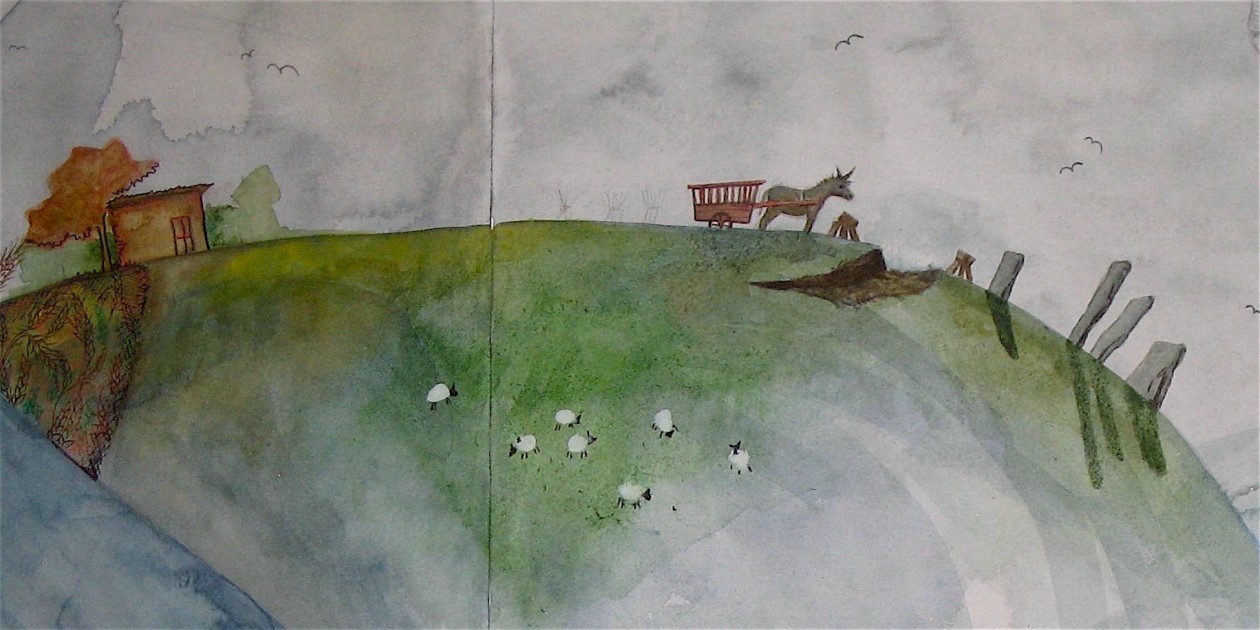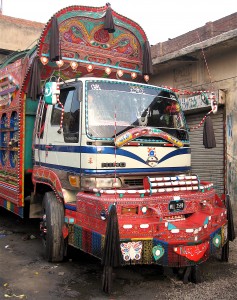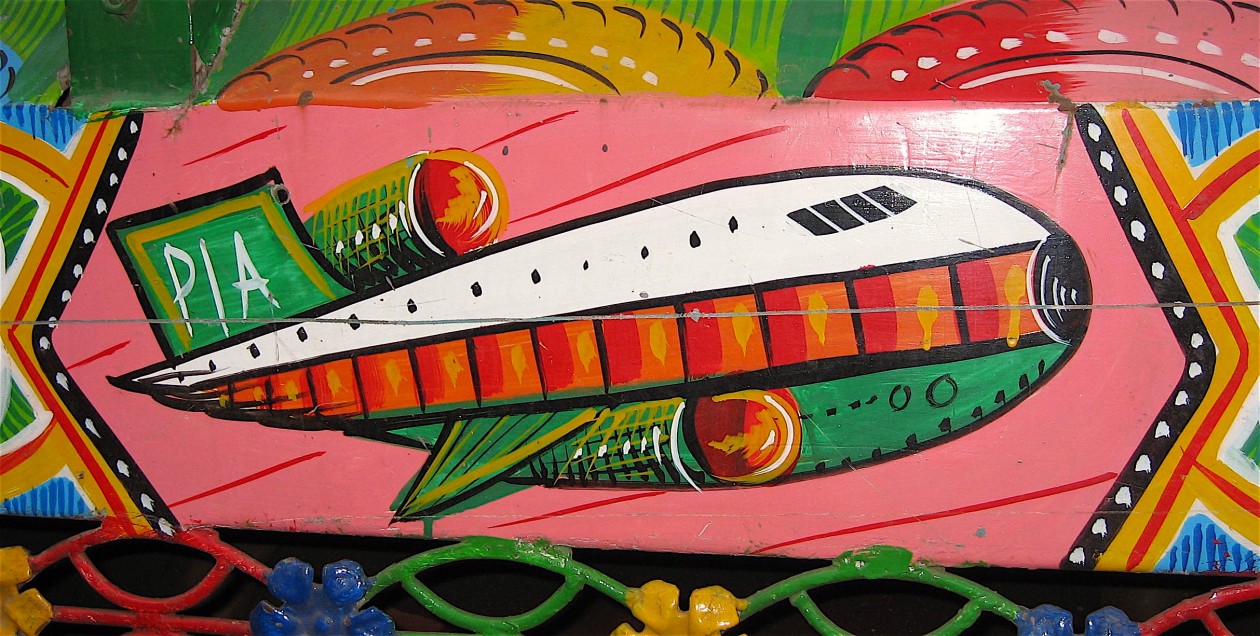Kate Leiper – Let’s go Lahore!
8th March 2016Kate Leiper is an artist and illustrator whose most recent work, “An Illustrated Treasury of Scottish Mythical Creatures”, was published by Floris in 2015. She is based in Edinburgh but was brought up on the north east coast of Scotland where she enjoyed playing on the beaches, exploring rock pools, building dens in the woods and getting stuck in trees. Here, she details her experiences of collaborating on new work for the Lahore Literary Festival & the Edinburgh International Book Festival —
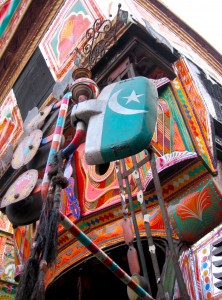 My curiosity was immediately piqued when into my inbox appeared an email entitled “Let’s go Lahore!”; a proposal to work collaboratively with a Pakistani illustrator in Lahore in response to a Scottish and a Pakistani storyteller. What an incredible opportunity! After a quick discussion with Ryan, one of the coordinators from Highlight Arts, and the swift reordering of existing deadlines, I accepted.
My curiosity was immediately piqued when into my inbox appeared an email entitled “Let’s go Lahore!”; a proposal to work collaboratively with a Pakistani illustrator in Lahore in response to a Scottish and a Pakistani storyteller. What an incredible opportunity! After a quick discussion with Ryan, one of the coordinators from Highlight Arts, and the swift reordering of existing deadlines, I accepted.
As in many a good tale, challenges come in threes and this adventure was no exception. The first one came before I’d even left home!
What art materials should I bring with me to Pakistan?
My day-to-day tool box is an old kitchen drawer over flowing with pastel pencils, not quite the kitchen sink but certainly impossible to transport to Pakistan. I therefore opted to bring with me my old and well travelled, tin watercolour box, a handful of brushes, a pencil case and a couple of large sketch books that could be easily taken apart to give large sheets of paper.
These are not my usual materials but I was aware that I was going to have to adapt to this project, which was going to be part of its fun.
On arriving in Lahore, I had the pleasure of meeting Mehreen Fatima. She is a recent graduate from the National College of Arts, Lahore, specialising in traditional miniature painting and already has a number of illustration projects under her belt, most recently the beautiful cover for “A Change in the Light”, a collection of poems written and translated in Urdu and English by our poet colleagues and published by Sang-e-meel.
Mehreen and I began our collaboration with a simple “show and tell” introduction of each other’s work. Although we come from and have been trained in two very different cultures, it was wonderful to discover how much we had in common through our art; we both create very intricate work, enjoy a rich palette of colour and share a similar appreciation for what illustration is and its function.
We both agree that illustrations should not simply replicate what is being said in an accompanying text. Instead, they should show what dwells between and beyond the boundaries set by words, seeping into the crevices and tickling the senses. Images may be built upon a scaffolding of words but they should also exist as a lexicon in their own right, onto which the viewer may attach their own personal narrative, experiences and meanings.
I therefore believe that visual literacy is a form of communication that shouldn’t be undervalued or misunderstood. What could be seen as a pretty picture in a picture book may be the means by which a child, struggling with literacy, might understand a text. It may make a book more accessible (less scary!) for a reluctant reader or someone with dyslexia. In a modern world where we see more and more migration, illustrations can help to introduce and explain the cultural norms of a society, along with helping to teach new vocabulary. Equally they can be used to overcome language barriers, helping us to understand why someone may have travelled so far and given up so much to start a new life in a far away land. Just as an epic story allows us to experience big adventures and events in a safe environment, illustrations are an ideal means of discovering the sometimes overwhelming power of our emotions. Very young children may experience their first lessons in compassion and empathy by following and learning to read the body language of their favourite book characters. Finally, illustrations shouldn’t just be the reserve of children. For adults too, complex feelings and delicate emotions, which may be challenging to express in words, can sometimes be depicted more directly through imagery.
Illustration by Mehreen Fatima & Kate Leiper
But back to the drawing board – I find that illustration, the planning process and producing a final piece, can be a very time consuming activity. For me an average illustration project needs 4 – 6 months, from initial ideas and drafts, through the editing stages and finally onto completion of the final pieces. This brings me promptly on to the second challenge presented to me by the Lahore project……
How do Mehreen and I complete an illustration in 5 days?
After spending a morning with our storytellers, Ian Stephen and Mujahid Eshai, listening to their vast repertoire of tales, Mehreen and I gathered our initial responses. We proposed presenting our work as a scroll. I think that the idea behind this was that as traditional oral storytellers travel light, i.e. with no books and the stories all tucked up in the nooks and crannies of their mind, we should follow in this spirit by creating an accompanying illustration which is easy to transport – hence the scroll. It is of course also a very traditional way of carrying parchment, whether it contains text or images. We decided that we should start off by creating landscapes and settings for and inspired by Ian and Mujahid’s stories.
In my head I knew that I would have to adapt my working practice, as I’d already told myself when packing my trusty watercolour box, but it wasn’t until the second day together did it hit Mehreen and me as to how much we were going to have to change our usual working practice in order to have a substantial enough piece for presentation at the Lahore Literary Festival. We’re both intricate and precise workers but this really had to be replaced by the big and the bold.
On my morning journey to Sang-e-meel, the publishing house where our temporary studio was situated, I began to take note of all the brightly coloured rickshaws and trucks. I described the design of a moon that I’d seen and Mehreen immediately introduced me to Truck Art. I was taken by it straight away. Not only is it colourful and eye catching, but in comparison to our usual methods of working, it gave us a technique for creating imagery more quickly. Inspired by the designs on Ian Stephen’s patterned jersey, we also introduced celtic knotwork which seemed to work really well with the bold Pakistani patterns. As well as painting the trucks, it is also traditional to use stickers cut into different motifs for decorating the lower parts of the vehicle. This part is often done by the owner of the truck as it requires less skill. Nevertheless, it was a great technique to incorporate into our piece and Mehreen created little cut out lobster claws to hang in our illustration. Mehreen’s traditional miniature painting was also incorporated into the sea/landscape that we were gradually building up. It’s a beautiful art which requires a lot of skill, patience and specialised equipment, including tiny squirrel-hair brushes which Mehreen makes herself.
Slowly, slowly, our piece started to come together, rather like a patchwork. We came up with motifs from the stories we were hearing and worked them into the scroll. Come Saturday, we finally finished and felt quite pleased with ourselves for having completed the task. Or so we thought! Then the third challenge came crashing in…..
How were we going to present our piece live at the Lahore Literary Festival?
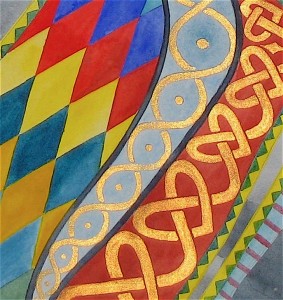 When I present finished work it is either framed and hanging on a wall or it’s within the pages of a book. Yes, I’ve spoken to audiences about my work but I have never presented it live and never while a story is being told at the same time. With the help of Ali, Dan and Ryan, a camera was set up with its lens directed downwards. The plan was that Mehreen and I would gradually guide our scroll past the lens, focussing in on details of interest, and this in turn would be projected live onto a large screen for the audience to watch. We had a trial run in Ali’s office but it was a bit frustrating as there wasn’t really enough room to manoeuvre the cumbersome work around. I think that it would be true to say that we felt a bit dispirited as time was running out and the pressure was on as our gig at Lahore Literary Festival approached. Looking back I also think that we were in a weird space, sort of between illustration and animation, neither in one camp nor the other. Anyway, the time came to present our work. Mehreen and I sat back stage with our camera all set up and our work laid out on a long table. For various reasons the people of Lahore Literary Festival had had a very challenging time organising and planning the event and this was true also for the technical team, who were still busy frantically working away, trying to hook up the camera to the two large screens each side of the stage. Ian and Mujahid had already done their introductions and started the first story when finally, we got the thumbs up, our work was being successfully projected on the screens.
When I present finished work it is either framed and hanging on a wall or it’s within the pages of a book. Yes, I’ve spoken to audiences about my work but I have never presented it live and never while a story is being told at the same time. With the help of Ali, Dan and Ryan, a camera was set up with its lens directed downwards. The plan was that Mehreen and I would gradually guide our scroll past the lens, focussing in on details of interest, and this in turn would be projected live onto a large screen for the audience to watch. We had a trial run in Ali’s office but it was a bit frustrating as there wasn’t really enough room to manoeuvre the cumbersome work around. I think that it would be true to say that we felt a bit dispirited as time was running out and the pressure was on as our gig at Lahore Literary Festival approached. Looking back I also think that we were in a weird space, sort of between illustration and animation, neither in one camp nor the other. Anyway, the time came to present our work. Mehreen and I sat back stage with our camera all set up and our work laid out on a long table. For various reasons the people of Lahore Literary Festival had had a very challenging time organising and planning the event and this was true also for the technical team, who were still busy frantically working away, trying to hook up the camera to the two large screens each side of the stage. Ian and Mujahid had already done their introductions and started the first story when finally, we got the thumbs up, our work was being successfully projected on the screens.
We slowly guided our work past the camera, zooming in and out of Scottish crofts, Truck Art style moons, cut out lobster claws, sheep grazing on the hills, a Pakistani farm house…..As Mehreen and I were back stage we never got a sense of what our illustration looked like up close, large scale and on the screens. We got lots of encouraging comments from Dan, Ryan and Ali but as of yet, I haven’t seen any photos and I’m not even sure if any exist……….but……………
……….for me this project was always so much more about process than outcome. I have had the privilege to meet and get to know an amazing bunch of people and I really hope that we have the chance to work together again in the future. I was lucky enough to visit an incredible country and my mind is still buzzing with the possibilities, opportunities and things that I just want to learn more about. I hope that one day I’ll be able to return, or as Mehreen would say, “inshAllah!”.
Thank you to Mehreen Fatima, Ian Stephen, Mujahid Eshai, Dan Gorman, Ryan Van Winkle and Ali Kamran for your company, ideas, help and reassurance during my time in Lahore.


